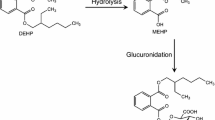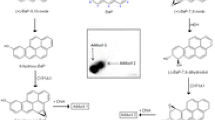Summary
Microsomal monoxygenases can oxidize the axial hydroxyl of the terminal digitoxosyl of digoxin (dg-3), digoxigenin bis-, and digoxigenin mono-digitoxoside (dg-2 and dg-1, respectively) to an oxo-group. The corresponding metabolites (15′-dehydro-dg-3, 9′-dehydro-dg-2, and 3′-dehydro-dg-l, respectively) have been identified by chromatographic and chemical methods. Only after this oxibation the terminal sugar can be split off, presumably by β-elimination. Therefore, for the degradation of dg-3 three successive cytochrome P450 catalyzed oxidations are necessary before digoxigenin (dg-0) can be obtained. The highest oxibation rate was observed with dg-1 (120–150 pmoles/mg microsomal protein/min) and by far the lowest with dg-2 (6–7 pmoles/min) as the substrate (concentration was 30/μM). The latter may contribute to the effect that dg-2 is the main dg-3 metabolite in vivo. Pretreatment of rats with canrenoate enhanced the microsomal oxidation of dg-3, dg-2, and dg-1 by a factor of 3.2, 2.3 and 1.3, respectively. In contrast, there was no increase after pretreatment with phénobarbital.
Similar content being viewed by others
References
Schmoldt, A., Rohloff, C.(1978) N.S. Arch. Pharmacol.: Dehydro-digitoxosides of digitoxigenin: Formation and importance for the digitoxin metbolism in the rat.305, 167–172.
Schmoldt, A. (1979) N.S. Arch. Pharmacol.: Stimulation and inhibition of digitoxin metabolism in vitro.307, R7 Supple.
Schmoldt, A. (1978) N.S. Arch. Pharmacol.: Increased digitoxin cleavage by liver microsomes of spironolactone-pretreated rats.305, 261–263.
Schmoldt, A., Buhr, S.L., Albersmeyer, K.: (1980) Biochem. Pharmacol.: Effects of inducers and inhibitors of rat liver monoxygenases on the digitoxin metabolism,29, 405–409.
Lüllmann, H., Peters, T., Seiler, K.U. (1971) Dtsch. Med. Wschr.: Uber die Verteilung und Biotransformation verschiedener Herzglykoside.96, 1018–1021.
Rietbrock, N., Abshagen, U., Bergmann, K.v., Kewitz, H. (1972) N.S. Arch. Pharmacol.: Pharmacokinetics of digoxin and its 4′“-acetyl- and methyl-derivatives.274, 171–181.
Dengler, H.J., Bodem, G., Wirth, K. (1973) Drug Res.: Pharmakokinetische Untersuchungen mit3H-Digoxin und3H-Lanatosid beim Menschen.23, 64–69.
Doherty, J.E. (1968) Amer. J. Med. Sei.: The clinical pharmacology of digitalis glycosides: A review.225, 382–414.
Bergmann, K.v., Abshagen, U., Rietbrock, N. (1972) N.S. Arch. Pharmacol.: Quantitative analysis of digoxin, 4′“-acetyl digoxin, 4”′-methyl digoxin and their metabolites in bile and urine of rats273 154–167.
Lage, G.L., Spratt, J.C. (1965) J. Pharmacol. Exp. Ther.:3H-digoxin metabolism by adult male rats in vitro.149, 248–256.
Satoh, D., Aoyama, K. (1970) Chem. Pharm. Bull.: Digitalis glycosides. XXXI. Stepwise degradation of polydigitoxosides of cardenolids18, 94–99.
Schmoldt, A., Rohloff, C. (1978) Arch. Pharm.: Darstellung und Eigenschaften von Dehydrodigitoxosiden des Digitoxigenins und Digoxigenins.311, 833–838.
Kutt, H., Fouts, J.R. (1971) J. Pharmacol. Exp. Ther.: Diphenylhydantoin metabolism by rat liver microsomes and some effects of drug or chemical pretreatment on the diphenylhydantoin metabolism by rat liver microsomal preparations.176, 11–18.
Omura, T., Sato, R. (1974) J. Biol. Chem.: The carbon monoxide-binding pigment of liver microsomes.239, 2370–2378.
Wirth, K.E., Frölich, J.E. (1974) Europ. J. Pharmacol.: Effect of spironolactone on excretion of3H-digoxin and its metabolites in rats.29, 43–51.
Castle, M.C., Lage, G.L. (1973) Res. Commun. Chem. Pathol. Pharmacol.:3H-digitoxin and its metabolites following spironolactone pretreatment of rats.6, 601–612.
Wirth, K.E., Frölich, J.C., Hollifield, J.W., Falkner, F.C., Sweetman, C.S., Oates J.A. (1976) Europ. J. Clin. Pharmacol.: Metabolism of digitoxin in man and its modification by spironolactone.9, 345–354.
Abshagen, U., Rietbrock, N. (1973) N.S. Arch. Pharmacol.: Metabolism of digoxigenin, digoxigenin mono-digitoxoside, and digoxigenin bis-digitoxoside in rats.276, 157–166.
Author information
Authors and Affiliations
Additional information
An erratum to this article is available at http://dx.doi.org/10.1007/BF03189509.
Rights and permissions
About this article
Cite this article
Schmoldt, A., Ahsendorf, B. Cleavage of digoxigenin digitoxosides by rat liver microsomes. European Journal of Drug Metabolism and Pharmacokinetics 5, 225–232 (1980). https://doi.org/10.1007/BF03189468
Received:
Issue Date:
DOI: https://doi.org/10.1007/BF03189468




